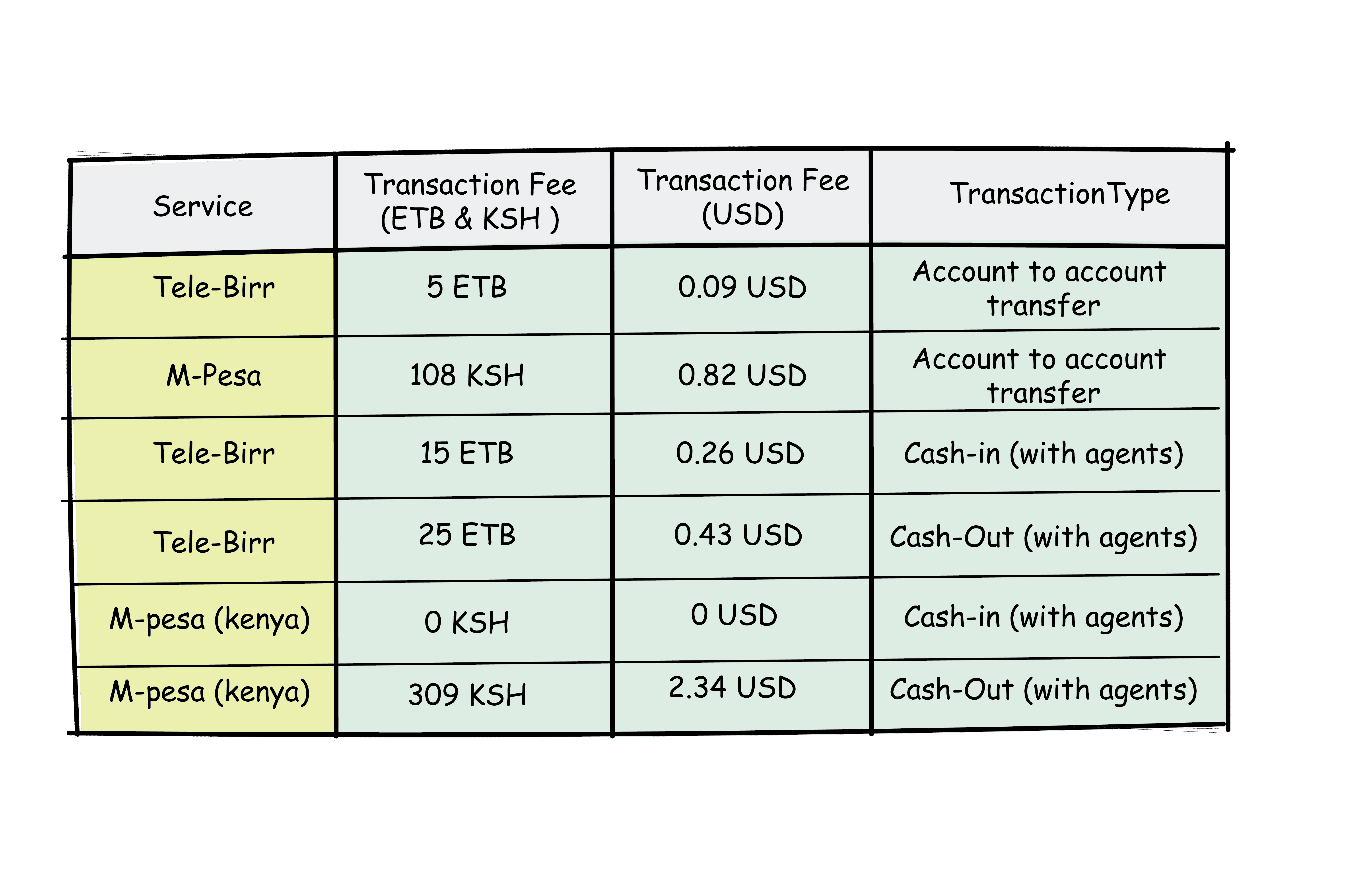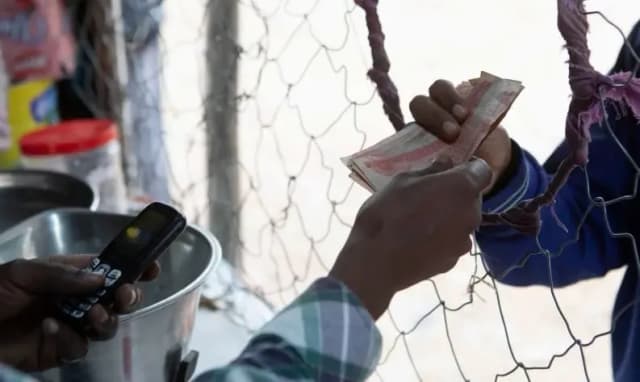Fintech 10 min read
Hidden Transaction Charges Hamper Ethiopia’s Digital Financial Progress

By Michael Thomas,
I recently came across a post on my X feed (though I still call it Twitter) where someone complained about their experience with the Commercial Bank of Ethiopia’s (CBE) mobile banking service. This individual had transferred 2,000 birr and was surprised that the transaction fee was 10 birr, which is 0.5% of the transfer amount. He didn’t know about transaction fees for person-to-person (P2P) transfers being charged by CBE. In comparison, if they had used telebirr to make the transfer amount to the same CBE account, the fee would have been 2 birr, which is only 0.1% of the transferred amount.
Financial services in Ethiopia are undergoing an evolution as more and more people are using digital channels (ATM, mobile banking, mobile money, and internet banking) to conduct their financial transactions. According to Myriam Said, Digital Advisor to the PMO, over 4 trillion birr has been transacted via digital channels between October 2022 and March 2023, with digital transactions overtaking cash transactions in the Ethiopian economy.
However, the increase in digital transactions in Ethiopia is bringing a new set of challenges, one of which revolves around the transparency of transaction fees. Many digital financial service providers in the country charge transaction fees, but when not communicated, such fees hide the cost of using their services.
This phenomenon results in what is commonly referred to as junk fees. Junk fees are surprise charges added to goods and services. They are often mandatory but not disclosed upfront. Financial service providers frequently hide the cost of using their services, making it difficult for consumers to compare prices accurately.

The justification and necessity of transaction fees in Ethiopia have been a topic of public discourse recently, especially concerning commercial banks. However, discussions about the transparency of these fees are rarely brought to the forefront.
Customers pay service charges and fees according to the bank’s terms and tariffs. Banks face expenses associated with vendor payments for essential systems like core banking and mobile banking services, as well as rising costs for materials such as ATMs and POS machines. One way they recoup these costs and make a profit is by imposing transaction fees. However, most banks are not sufficiently transparent with the public about their fee structures.
“It’s puzzling why such essential information is not readily available on ATM screens, displayed at ATM locations, inside mobile apps, bank branches, or even on the banks’ websites. It is remarkable that acquiring this information necessitates conducting extensive research,” Tewodros Tassew, a digital financial services (DFS) expert, shares his observation in an article published in 2023.
Customers deserve clarity and transparency in understanding the costs associated with their financial transactions. Price transparency and fee disclosure empower consumers to make informed decisions, compare products, and foster healthy competition among financial institutions.
When they are not transparent, customers, particularly those with limited banking experience, may face unexpected charges and lose trust in digital financial services. The low awareness and lack of transparency regarding junk fees could significantly impact trust among users. This is especially crucial in countries like Ethiopia, where the median transaction value is low and financial inclusion is a work in progress. The lack of transparency can increase disputes between financial service providers and users, ultimately affecting financial inclusion efforts through various digital finance channels.
What type of fees exist in Digital Financial Services in Ethiopia?
Different kinds of junk fees exist globally in various sectors, from banking and online shopping to subscription services, and travel. According to the American National Economic Council, ten specific kinds of junk fees amount to $90 billion per year in the United States, averaging more than $650 per household per year.
In Ethiopia’s DFS space, there are fees associated with ATM withdrawal, P2P transactions, mobile account maintenance, loan services, and foreign exchange (forex).
In addition, fees imposed on digital transactions differ from bank to bank, channel to channel, and amount to amount. For example, withdrawing 1000 birr from an ATM operated by CBE using a debit card issued by CBE costs 3.50 birr. In contrast, withdrawing 1000 birr from the same ATM using a card issued by a different bank costs the customer 5 birr.
Use Case: A cashless experiment in Addis Ababa unveils hidden transaction fees
Nine months ago, Fitsum Admasu, founder and CEO of FIRMA Communications, a local creative agency, made a social experiment where he tried to live cashless for a month and a half in Addis Ababa.
His experiment was surprisingly successful. Armed with multiple ATMs from different banks and diverse mobile banking options at his fingertips, he was able to switch between accounts and payment methods, doing 410 transactions.
But his experiment also revealed that transaction fees cannot be ignored if we intend to become a cash-lite society. Fitsum racked up nearly 4,000 birr in card transaction fees alone.
Which Ethiopian financial institutions publicly disclose information about their DFS transaction fees?
The transparency of transaction fees in Ethiopia varies across different digital financial channels. For instance, most banks do not display the transaction fee charged to the customer when withdrawing money from ATMs. However, while these fees are printed on the receipts, this action may not be sufficient to argue that customers are adequately informed of the fees before making a decision.
On the other hand, transparency is better when it comes to mobile banking and mobile money. Some banks, such as Awash Bank, Dashen Bank, Zemen Bank, and the Cooperative Bank of Oromia, display the transaction fees they charge when users make P2P transactions on their respective mobile banking platforms.
One notable exception is CBE, the largest commercial bank and the leading mobile banking platform in Ethiopia. Between June 2022 and June 2023, around 2.4 trillion birr worth of transactions were conducted through the CBE mobile banking platform. However, CBE does not provide a fee structure for P2P transactions in its mobile banking application.
M-Pesa and telebirr, the two mobile money wallets in Ethiopia offered by telecom operators, also set a positive example by providing a detailed fee structure for various financial services. Both services disclose the fee they will deduct from transactions when a customer requests to transfer money from one user to another. This information is made available to users during transactions through a confirmation screen that includes crucial details such as the amount, the recipient, and the transaction fee. This transparency extends to the transaction completion process for both mobile wallet services. The image below shows screenshot images of some of the DFS platforms that have transparent transaction fees

Similarly, payment gateway operators registered such as Chapa, ArifPay, and SantimPay, are also upfront about their fee structures, ensuring there are no hidden charges to surprise consumers. These operators provide comprehensive fee information for their services, promoting transparency and trust.
But EthSwitch conducts mass marketing campaigns, including TV and radio advertisements targeting end-users. These advertisements elaborate on the services it offers and emphasize how transferring money from one bank to another has never been easier. However, if users take action based on these ads and use EthSwitch, they will eventually encounter a surprise transaction fee that EthSwitch charges. This lack of transparency could potentially impact the consumer experience.
Why should financial service providers disclose their transaction fees to users?
Markets work when firms compete on an even playing field, displaying prices to consumers in a fair and transparent manner. Mandatory hidden fees risk obscuring the full price, making it harder for consumers to compare and choose their preferred product and the best deal. These fees can also create an uneven playing field for businesses, making firms that price in a fair and transparent manner seem more expensive than their rivals.
According to Tewodros, without proper fee disclosure, customers, particularly those with limited banking experience, may face unexpected charges and lose trust in digital financial services. Unlike traditional banking services that allow for direct communication and information acquisition, digital channels often lack human interaction. Consequently, fees are automatically deducted during digital transactions, leaving customers with little opportunity to approve or question these charges. Such negative experiences impact the ambition of creating an inclusive financial sector and a cash-lite economy. To foster customer adoption of digital financial services, it is essential to maintain the principles of pricing transparency.
Regulation Review
The Ethiopian government introduced the Financial Consumer Protection Directive in 2020. The directive aims to regulate all financial service providers and promote financial inclusion, trust, and confidence in the financial system while maintaining stability. The directive requires service providers to provide key fact statements to clients, which should offer comprehensive information on financial services. The regulation should also emphasize that financial service providers should not impose any undisclosed fees on customers.
After the regulation was passed in 2020, the National Bank of Ethiopia (NBE) established the ‘Financial Consumer Protection and Education Directorate’, which aims to implement the regulations effectively. This shows that the regulator has taken consumer protection as a key enabler for achieving financial inclusion and stability in Ethiopia.
Best global practices with junk fees
The challenge of junk fees that are hidden from customers is found across developing and developed countries.
Kenya
The Competition Authority of Kenya (CAK) issued a regulation in 2016 requiring all digital financial service providers to present customers with full information on the costs of the financial services before they conduct a transaction. This transparency has led to increased customer awareness of transfer fees, according to a study by the Consultative Group to Assist the Poor (CGAP). Empowered by this knowledge, customers can now make informed decisions about the costs associated with transactions. The study also revealed that many customers previously avoided DFS services due to the misconception that they were expensive. The clear pricing information has dispelled this myth and allowed customers to discover that these services can be cost-effective.
United States of America
Combating hidden and deceptive fees has been a priority of the Biden-Harris Administration’s economic agenda. As part of this agenda, agencies across the executive branch have proposed and implemented several rules to crack down on junk fees in areas they regulate. The Consumer Financial Protection Bureau (CFPB) has launched an initiative to save households billions of dollars a year by reducing exploitative junk fees charged by banks and financial companies.
Financial institutions in the U.S. are currently expected to incorporate all necessary fees into the initial price quoted to customers.
The Administration states that its action to crack down on junk fees is already yielding billions of dollars in savings for Americans, and going forward, CFPB actions alone will likely save Americans roughly $19.5 billion annually.
Cross-comparison of transaction fees in similar markets
Comparing transaction fees between telebirr and M-Pesa in Kenya reveals telebirr’s potential cost advantage for account-to-account transfers. Telebirr charges a maximum of 5 birr (around $0.09) for a 75,000 birr transfer. In contrast, M-Pesa in Kenya charges roughly 108 KSH (around $0.82) for the same transfer of 174,725.27 KSH (the Kenyan shilling equivalent of 75,000 birr).
However, telebirr becomes less cost-effective for depositing cash (cash-in) via agents. For a 75,000 birr transfer, telebirr agents charge a 15 birr commission, while M-Pesa offers free cash-in. For withdrawing cash (cash-out), telebirr is more affordable. Cashing out 75,000 birr at a telebirr agent costs around 25 birr, whereas M-Pesa charges a significantly higher fee of 133 birr for the same amount.

In addition, IM Bank in Rwanda’s transaction fees for various banking services were compared with those of CBE. Account-to-account transfers are free at IM Bank, whereas CBE charges fees that depend on the transaction amount: 5 birr for transfers below 10,000 birr, 10 birr for transfers between 10,000 and 100,000 birr, and an additional 5 birr for every 100,000 birr above that.
Mobile banking accounts incur no monthly maintenance fee at IM Bank, while CBE charges 5 birr per month. POS transactions are both free at IM Bank and CBE (except for transactions done through Cash Advance POS machines).
Conclusion
The average Ethiopian bank account balance falls below 4,000 birr, with even lower balances in rural and remote areas. A World Bank study also indicates that saving for emergencies is a primary reason Ethiopians utilize various financial service providers. These two factors highlight the significance of transaction fees in Ethiopia.
Transparency regarding fees is a key foundation for trust among the unbanked population. Clear communication about the different types of fees associated with financial service providers empowers users to make informed decisions. Highlighting transaction fees, as exemplified by Kenya’s experience, helps dispel misconceptions about digital finance.
In addition, the President of CBE recently stated that providing branch-based financial services typically costs an average of 70-100 birr per person. Building trust in DFS users and expanding the use cases of digital finance among rural users can streamline banking operations for different banks, reducing the overall operational and capital costs associated with expanding banking services. These cost reductions can then translate into lower-cost digital financial service products for users.
_____
Michael Tomas Gebremariam, is a Consultant at Shega Insights, and has a passion for exploring the intersection of the digital economy, behavioral science, and leadership. With a deep interest in these fields, Michael seeks to understand how technology can be used to transform the lives of individuals and communities in Ethiopia and beyond. For any inquiries or to connect with Michael, he can be reached at michael@shega.org.




